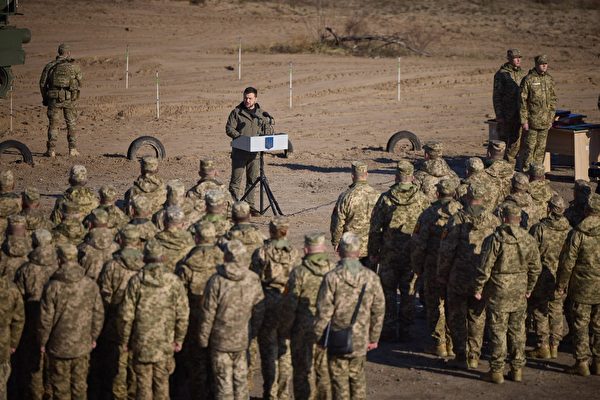In the midst of the nearly two and a half years since Russia invaded Ukraine, Ukraine unexpectedly launched a large-scale cross-border attack on the Russian mainland of Kursk on August 6th, shocking the Kremlin and surprising its allies in Kyiv. This move may have also caught many military strategic experts off guard.
Ukrainian President Zelensky stated on the 12th, “The war has come back to Russia!” Many are questioning why Ukraine waited over two years to launch a large-scale assault on Russian soil after facing Russian aggression.
According to Associate Professor Zheng Qinmo from the Department of Diplomacy at Tamkang University in Taiwan, the key factor is the lifting of the ban on Ukraine’s use of US military weapons on Russian territory in May of this year. The US emphasized that Ukraine did not violate the regulations by deploying their military equipment in Russian territory, effectively crossing the red line of Russian soil.
EU countries, including Germany, also emphasized that under the “laws of war,” Ukraine has the right to counterattack incursions on their soil. The international community largely supports Ukraine in this matter.
With the introduction of US F-16s, HIMARS missile systems, ATACMS (Army Tactical Missile System) along with German Leopard 2 tanks, Ukraine had significant air cover and support. Additionally, it is unlikely that Russia laid landmines on its own soil, allowing Ukrainian forces to advance into Kursk swiftly.
Zheng Qinmo believes that this surprise attack had been planned for a considerable period. Recent foreign media reports indicate that Ukraine had started digging trenches and fortifying defense structures in occupied areas, with air force units deployed. This sets the stage for a potentially prolonged standoff.
Originally, both sides had entrenched defenses in the eastern Ukrainian battlefield, resulting in a stalemate. From January to the present day, out of the nearly one hundred daily battles, Russia has expanded its occupation of Ukrainian land by approximately 900 square kilometers. However, in less than five days, Ukraine managed to occupy over 1000 square kilometers of Russian territory.
This surprise attack did not decisively change the course of the conflict, but it poses a significant threat to Putin and is a major blow to his prestige. The Kremlin operates under a culture that reveres strong leaders, so Ukraine’s invasion into Russian territory is unprecedented since the German army in World War II. This has dealt a great blow to Putin’s image.
Facing Ukraine’s agile tactics and continuous strategic support from the US and NATO, Zheng Qinmo suggests that the situation on the battlefield may become clearer by the end of the year, as indicated by Zelensky at the Supreme Command Council meeting on Monday. This could lead to military or diplomatic negotiations.
According to reports from The Wall Street Journal, Ukraine’s swift invasion and occupation of Kursk Oblast in Russia have greatly embarrassed Putin and inspired Ukrainian morale. However, Ukrainian leadership faces a dilemma: is it worth committing more troops and military equipment to expand the gains?
Zheng Qinmo further adds that recent foreign media reports suggest Ukraine has initiated a counteroffensive in a place called Kinburn Spit bordering Crimea and Kherson. This could potentially lead to a major counteroffensive in eastern Ukraine aimed at regaining control of Crimea.
Zheng Qinmo concludes by stating that Ukraine has become a significant military force in Europe. Since Russia’s occupation of Crimea in 2014, they have supported local forces in eastern Ukraine’s Donbass region, causing a decade-long conflict. Following Russia’s invasion in 2022, Ukraine has been transformed into a formidable military power that poses a substantial threat to Russia’s border security.
Some analysts argue that Ukraine is only 450 kilometers away from Moscow, potentially following a similar pattern to the June 2023 uprising in Prigozhin. However, Zheng Qinmo believes that Ukraine’s capacity falls short, and the West is unlikely to permit further escalation, fearing a third world war. He suggests that Ukraine’s main objectives lie in relieving military pressure in eastern Ukraine, damaging Russia’s energy infrastructure in the occupied regions to further suppress Russia economically.
In July, the NATO summit declaration saw all 32 member countries approve Ukraine’s membership, directly implicating China in facilitating Russia’s attacks on Ukraine. Zheng Qinmo points out that China is a key supporter of Russia, and claims have surfaced that Russia has requested increased assistance from China. How China responds to this will be closely monitored by the international community.
Zheng Qinmo notes that President Xi Jinping of China is currently the only one who can assist Putin. Whether Xi Jinping allows Putin’s regime to collapse or risks alienating the West is a dilemma. Supporting Russia could worsen China’s already precarious economic situation. Thus, Xi Jinping faces significant pressure. In conclusion, the ongoing conflict between Russia and Ukraine is at a major turning point, likely to have a significant impact on the global geopolitical landscape.

